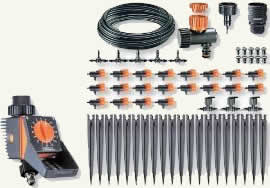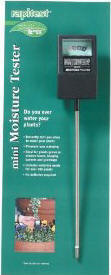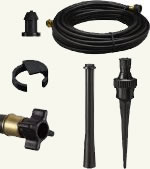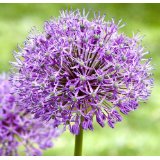Watering Bulbs:
It is important that after planting any spring flowering bulb that the beds be watered. Watering aids in settling the soil and provides the moisture necessary to commence root growth. Bulbs that are planted in the fall must commence to root before the cold weather sets in. Over watering at this time or any time can create bulb rot – avoid over watering. Drip irrigation (Figure 1) works very well with all bulb plantings.

Figure 1 - Drip irrigation system
If your soil is dry, you should commence watering spring and summer plants as soon as the first flower buds appear on the plant.
Do not just water the surface! The larger plant bulbs were planted 6 to 8 inches deep and water needs to permeate the soil to below that depth in order to reach the new root growth.
It is highly recommended that you use a tester or meter to determine the moisture content of the soil, as shown in Figure 2.

Figure 2 - Soil moisture tester
Continuous watering is needed throughout the growth of the plant from bud to bloom and early foliage, the plant needs approximately 1 inch of water per week (rainfall or supplemental watering). Try to keep water away from the blooms. If you are providing supplemental watering, use drip irrigation or a flower watering soaker hose, as shown in Figure 3, making sure that the water is aimed at the base of the plant.

Figure 3 - Flower soaker hose kit
Shallow planted bulbs such as alliums will quickly rot if over-watered in the summer heat.

Figure 4 - Large bloom alliums
Removing Foliage:
Spring flowers create a beautiful garden, with a wide variety of colors, shapes, and heights that is, until the blooms die, and you are left with a very unappealing quantity of green foliage. Although this could be unappealing, the foliage should not be cut or mowed until it turns a shade of yellow and dies naturally.
Some aesthetic problems maybe caused with the smaller flowering bulb varieties such as snowdrops and squill, as the foliage on these plants tends to die quite rapidly. Tulips and daffodils have much larger bulbs and much hardier and larger stocks of foliage. These plants may take several weeks to die naturally.
Cutting the foliage prematurely can cause damage to the bulb and prevent it from growing next year.
After flowering, the plant needs the green leaves to manufacture food (photosynthesis) that is then stored in the bulb for next year’s growth. Prematurely cutting the foliage means that the plant can no longer manufacture nutrients.
If the foliage is a visual concern, you can divert attention from the foliage by planting bulbs in between colorful annual plants.
Additional information on Planting Bulbs
Part 1 – Soil Preparation, Fertilizing;
Part 2 – Planting Location, Planting Depth;
Part 4 – Staking, Mulching, Storing;
